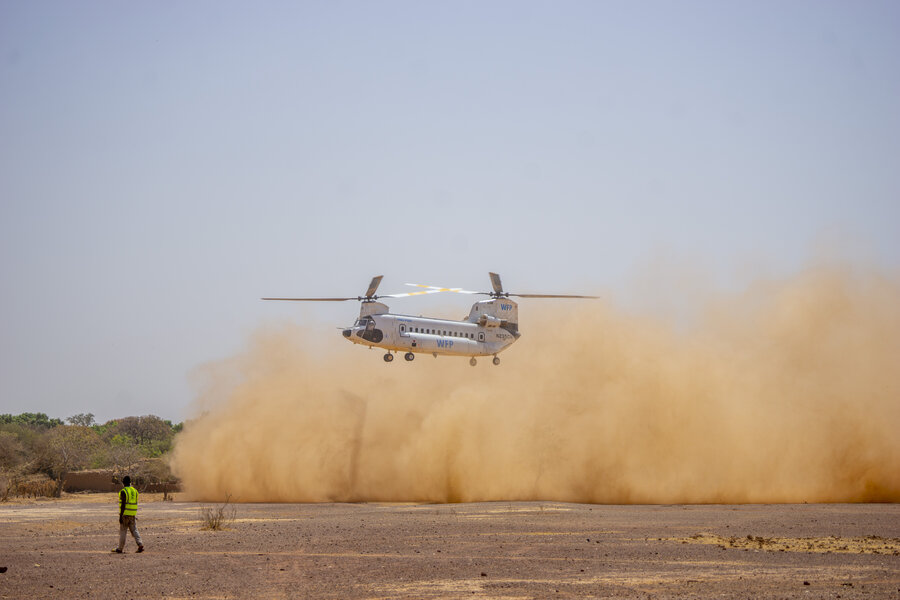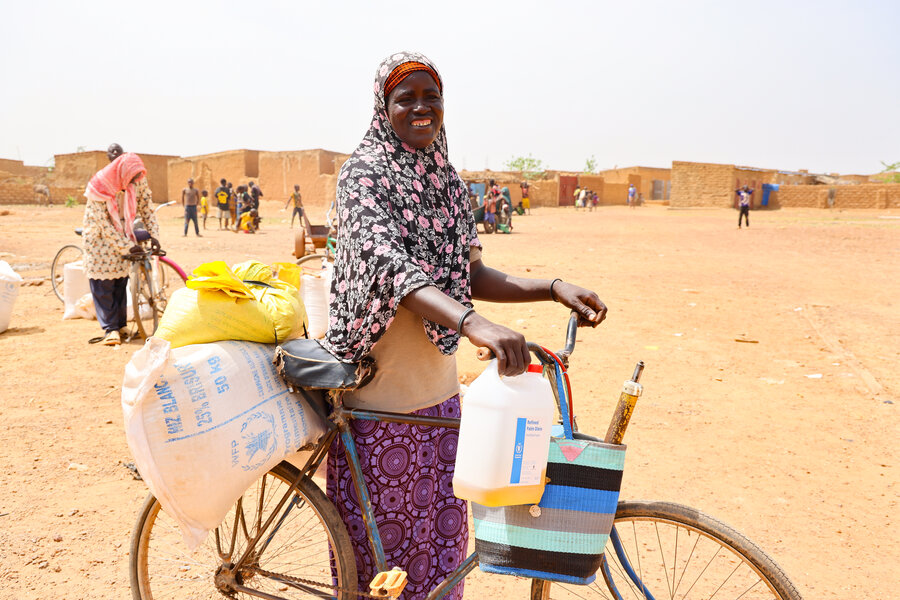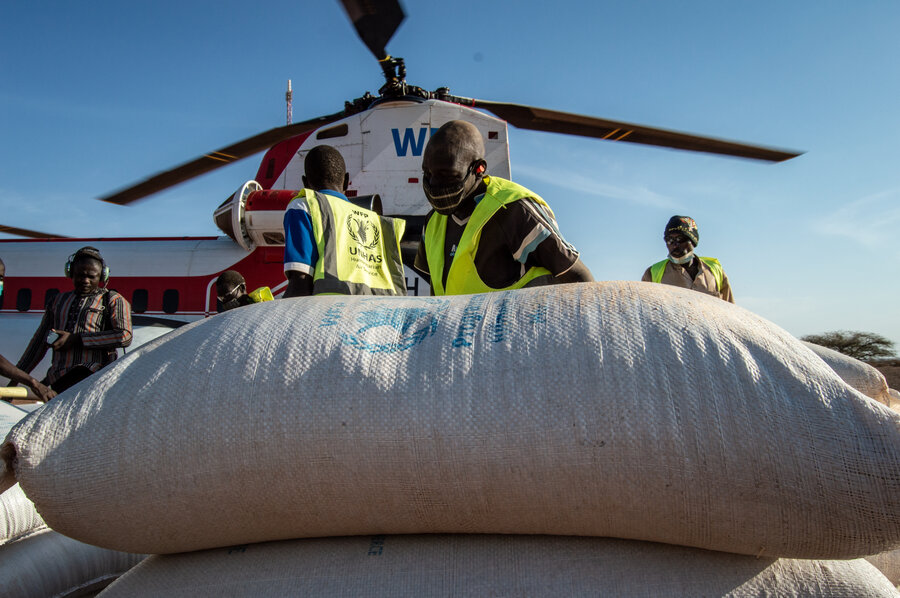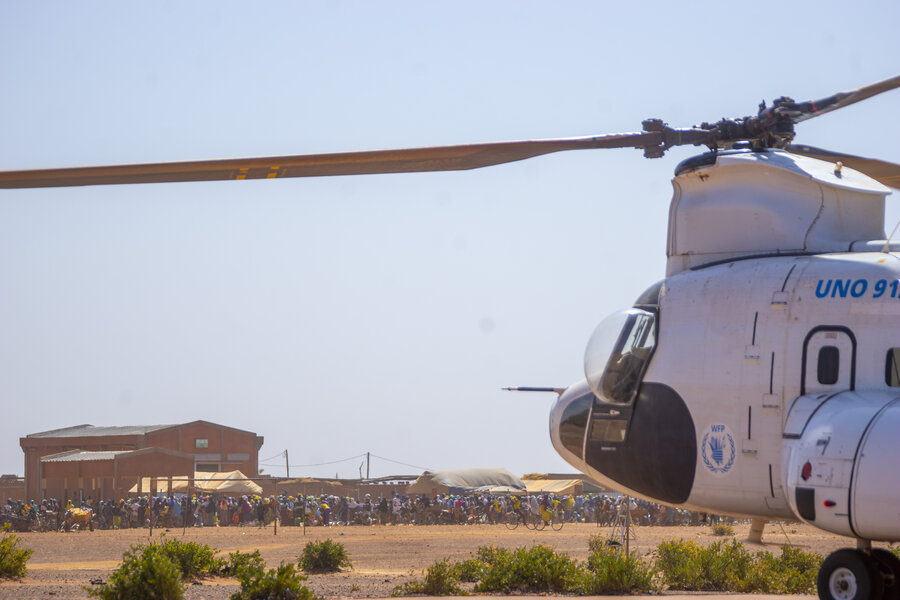For Burkina Faso’s cut-off communities, WFP food airlifts can be lifesavers
The dual-rotor helicopter touching down on Fada N’gourma’s dusty airstrip is a game changer for the hungry communities here in eastern Burkina Faso. Minutes later, American pilot Christine Brown emerges, the sizzling, late-morning sun soaking into her cargo pants and long-sleeved shirt as she monitors World Food Programme (WFP) food and nutritional assistance being offloaded.
“Flying to transport food to those who need it is the most fulfilling mission I have ever done,” says 38-year-old Brown of her job delivering WFP support, along with humanitarian workers, to some of Burkina Faso’s most remote, food-insecure and conflict-torn hotspots. ”It is heartbreaking to see all the kids out there and to know what they are going through.”
Rising before dawn and returning at sunset to her base in the capital, Ouagadougou, Brown counts among the dozens of contractors and staff responsible for our airlifts and the broader WFP-managed United Nations Humanitarian Air Service (UNHAS) in Burkina Faso.
In this West African country, facing insecurity and widespread humanitarian needs, their role is vital in reaching places countrywide that are too dangerous to access by road.

"Without these airlifts, many of these communities would have no other means to survive,” says Elvira Pruscini, WFP's Representative and Country Director in Burkina Faso. “We are literally a lifeline for tens of thousands of people every month, ensuring the timely delivery of life-saving food and nutrition assistance to the hardest-to-reach areas.”
On any given day, pilots like Brown transport roughly six metric tons of food – the weight equivalent of an African elephant - to northern and eastern Burkina Faso, where hunger numbers are the most alarming. The airlifted goods – accounting for one-sixth of total monthly food and nutritional assistance that WFP delivers to food-insecure communities countrywide – reached more than half a million people in 2023.
Malnutrition
That’s made the airlifts a key part of WFP’s humanitarian response, allowing us to assist more than 1.2 million displaced people last year. Among them are young children and pregnant and breastfeeding women and girls, who are often the most vulnerable to malnutrition, which soars beyond emergency levels in some places.
The fallout of climate change and desertification have helped to intensify hunger here. But rising armed conflict has fed a dire humanitarian crisis. More than 2 million people are internally displaced, according to government estimates. Some 2.7 million face acute food insecurity.

“Without the assistance of WFP, we wouldn’t have anything to eat,” says Zourata, a mother of six, who lives in the northern town of Titao. Surrounded by armed groups, it can only be reached by air. “We cannot leave, nor do we have any way to cultivate crops, as we have no access to land.”
The food Brown delivers to Fada N’gourma – bags of grain and boxes of nutritional supplement – is transported to a nearby distribution center for the waiting communities. By that time, the pilot is already on her way to her next stop. She has a busy day ahead.
“This job is very rewarding for me, but it’s also very difficult and it’s a long way from my home –so I always miss my family,” says Brown, who is based in the US state of Idaho during her non-working life. But, she adds, “It’s a great and beautiful country to fly over and I’m very lucky to be here.”

A seasoned helicopter pilot who has chalked up more than 6,000 flying hours in places like Afghanistan, Turkey and the US, Brown fell in love with the profession as a child, during a vacation in southern Africa. She still remembers her first, exhilarating experience in the cockpit - as a flight student, commanding a two-seater R22 helicopter in 2012.
“My first flight was scary,” Brown recalls. “I was not exactly sure what I was doing. But once you are up there, nothing beats the feeling. You feel like a small part of the world. There is nothing else to think about except flying.”
Roster of women
Early last year she began working for the WFP airlifts and the broader UNHAS air operation in Burkina Faso, as the only female UNHAS pilot in that country. But she’s part of a growing roster of women involved in such missions.
"The women who work for us are a talented, dedicated and vital part of the UNHAS team,” says WFP’s Chief of Aviation, Franklyn Frimpong. “They accomplish extraordinary things in some of the most difficult parts of the world.”
For Brown, however, being a successful pilot has nothing to do with gender.
“Flying is a human skill,” she says. “We all have the same arms and legs. For me, I go to work, and I do the best I can. Everyone works hard and we all work together as a team.”

On this day, Brown heads to four different eastern towns, reaching all the way to the country’s border with Niger. The flight provides stunning vistas of Burkina Faso’s arid landscape, punctuated by trees and mud-brick villages. The sun is starting to set by the time she finally gets back to Ouagadougou. The trip has been worth it.
“When we land to deliver assistance in these very isolated communities, we see how happy the people are to see us,” Brown says, “and we feel so good about bringing the food.”
In 2023, WFP airlifts provided roughly 11,500 tons of food and assistance to more than half a million people in cutoff towns across Burkina Faso. In addition to the airlifts, WFP also manages the UNHAS air operation. It forms the backbone of the humanitarian response in that country, having transported more than 27,000 humanitarian workers to difficult-to-reach areas last year alone.
UNHAS’s vital work in Burkina Faso has been possible thanks to financial contributions from the European Union, Luxembourg, Switzerland and the United States.


